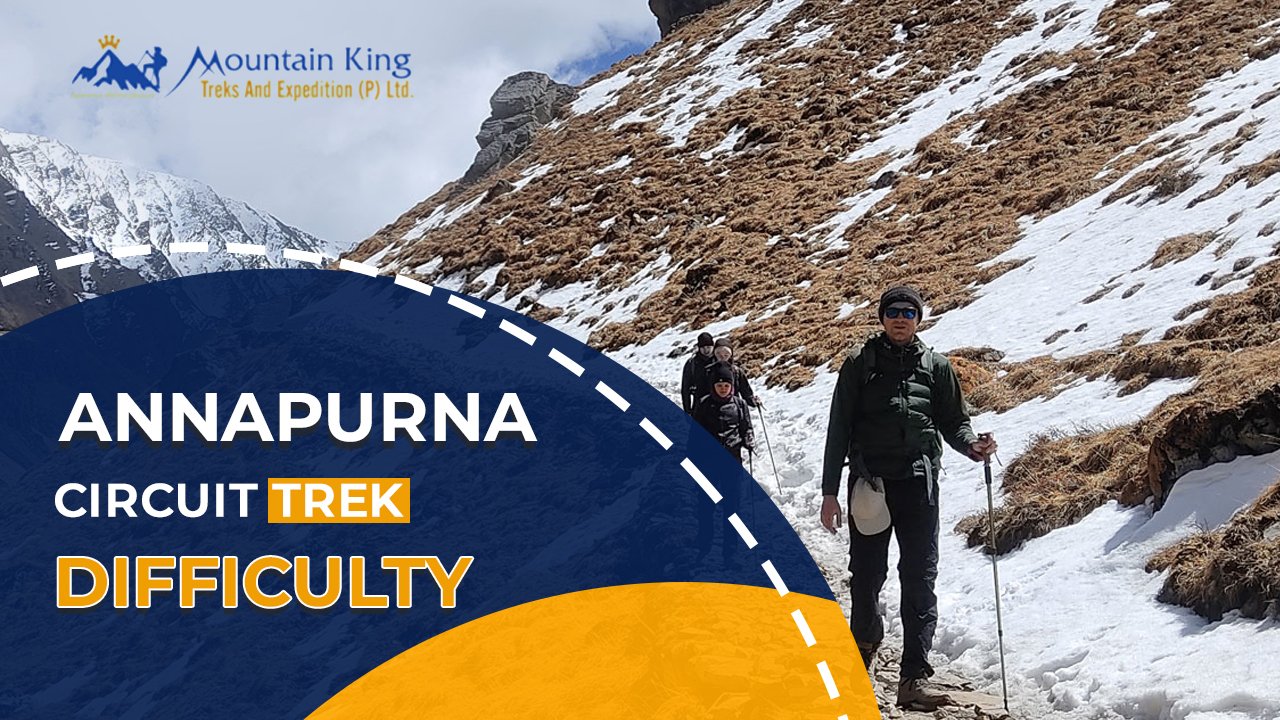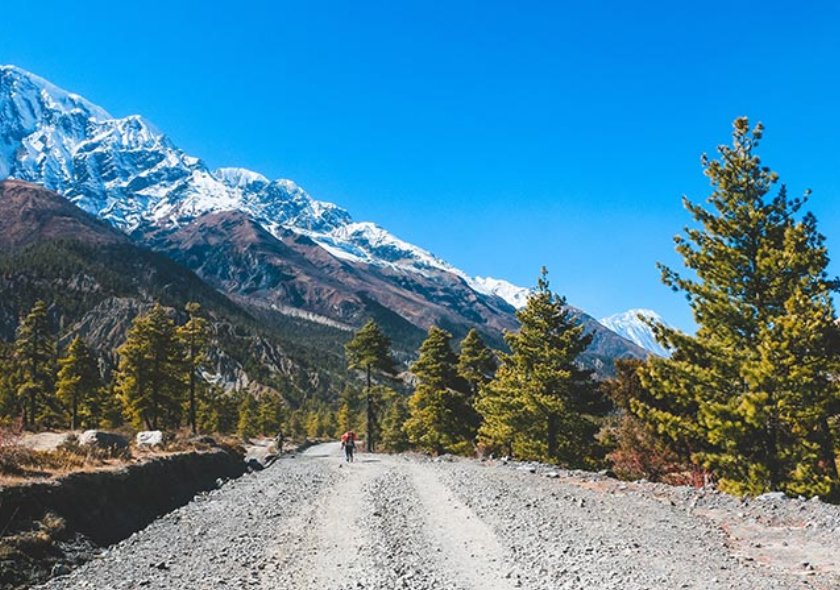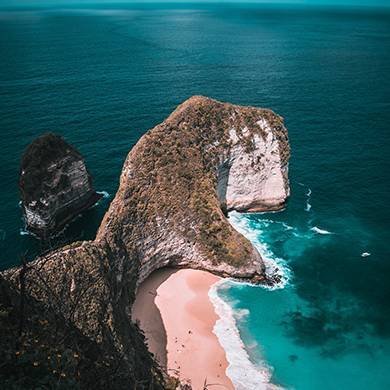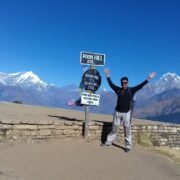
Annapurna Circuit Trek Difficulty: A Comprehensive Guide
The Annapurna Circuit Trek, one of the most iconic trekking routes in Nepal, offers a perfect blend of adventure, cultural immersion, and breathtaking landscapes. However, trekking to an altitude of 5,416 meters at Thorong La Pass is no walk in the park. This journey tests your physical stamina and mental resilience while rewarding you with unparalleled views and experiences.
In this blog, we’ll explore the factors contributing to the difficulty of the Annapurna Circuit Trek and provide practical tips to help you prepare. Whether you’re a beginner or a seasoned trekker, this guide from Mountain King Treks ensures you’re well-informed for the challenge.
1. Overview of the Annapurna Circuit Trek
The Annapurna Circuit, also known as the Annapurna Round Trek, is among the oldest trekking routes in Nepal. Traversing a diverse range of landscapes, cultures, and altitudes, it’s a favorite for adventure enthusiasts.
- Maximum Altitude: Thorong La Pass at 5,416 m
- Route Highlights: Villages of Gurung, Thakali, and Tibetan origins, lush forests, alpine meadows, and arid highlands.
- Classic Route: Starts from Besisahar and ends at Nayapul, with options to shorten the trek by using local transport.
The construction of roads has altered parts of the route, but it remains a must-do trek for those seeking a mix of natural beauty and cultural diversity.
2. What Makes the Annapurna Circuit Trek Challenging?

Several factors contribute to the difficulty of the Annapurna Circuit Trek:
- High Altitude: The trek reaches 5,416 meters, where oxygen levels are significantly lower.
- Long Walking Hours: Expect to walk 6-8 hours daily for over two weeks.
- Diverse Terrain: From subtropical forests to arid, rocky landscapes.
- Remote Locations: Limited access to modern facilities in high-altitude areas.
A reliable trekking agency like Mountain King Treks can help you navigate these challenges with proper planning.
3. Physical and Mental Preparation for the Trek
A successful Annapurna Circuit Trek requires robust physical fitness and mental determination. Here’s how you can prepare:
- Cardio Exercises: Running, swimming, and cycling improve stamina.
- Strength Training: Focus on leg muscles to handle uphill and downhill sections.
- Diet: Avoid greasy and processed foods; focus on a balanced diet rich in protein and carbohydrates.
- Practice Hiking: Take practice hikes with a loaded backpack to simulate trekking conditions.
4. Impact of Altitude on Trekking Difficulty
The trek’s high-altitude segments pose the greatest challenges:
- Altitude Sickness: Symptoms include headaches, nausea, and shortness of breath.
- Adaptation Time: Acclimatization days are critical to avoid severe altitude-related issues.
Trekkers coming from lower altitudes must prioritize acclimatization and stay hydrated.
5. Thorong La Pass: The Most Challenging Section
Crossing Thorong La Pass is the pinnacle of the Annapurna Circuit Trek—and its most challenging part.
- Early Start: Trekkers begin before dawn to avoid strong winds.
- Steep Climbs and Descents: Both sides of the pass require stamina and caution.
- High Camp vs. Thorong Phedi: Spending the night at High Camp shortens the ascent but can lead to poor sleep due to high altitude.
6. Weather Conditions Along the Route
Weather plays a crucial role in determining the trek’s difficulty. Here’s a seasonal breakdown:
- Spring (March-May): Best season; blooming rhododendrons and clear skies.
- Autumn (September-November): Excellent visibility and stable weather.
- Winter (December-February): Harsh cold and snow make the trek more challenging.
- Monsoon (June-August): Trails become slippery and leech-infested.
7. Does Adding Tilicho Lake Make It Harder?
Tilicho Lake, at 4,919 meters, is a popular detour from the Annapurna Circuit. While it offers stunning views, it increases the trek’s difficulty due to:
- Additional Walking Days: Adds 3-4 days to your itinerary.
- Steep Trails: Requires more uphill trekking and careful footing.
8. Common Problems Trekkers Face
Trekkers on the Annapurna Circuit frequently encounter the following issues:
- Unpredictable Weather: Sudden changes can disrupt plans.
- Altitude Sickness: Especially common above 3,500 meters.
- Limited Facilities: Basic accommodation and food options in remote areas.
- Connectivity Issues: Weak or no mobile networks in high-altitude zones.
Hiring an experienced guide from Mountain King Treks ensures a smoother journey.
9. Tips to Overcome Challenges on the Annapurna Circuit
- Acclimatize Properly: Spend extra days at key points like Manang.
- Pack Smart: Carry essentials like warm layers, a first-aid kit, and energy bars.
- Stay Hydrated: Drink plenty of water to combat altitude effects.
- Choose the Right Season: Spring and autumn offer the most favorable conditions.
10. Importance of Travel Insurance
Travel insurance is a non-negotiable necessity for trekking in Nepal. Ensure your policy covers:
- Emergency helicopter rescue
- Medical expenses
- Trip cancellations or delays
Mountain King Treks advises all clients to secure insurance before embarking on the trek.
11. Alternative Routes to Consider
If Thorong La Pass feels too daunting, consider these options:
- Meso Kanta La Pass (5,099 m): A less crowded but equally challenging alternative.
- Cycling the Circuit: Suitable for adventurous cyclists on select sections.
These variations offer unique perspectives of the Annapurna region.
12. Final Thoughts
The Annapurna Circuit Trek is a rewarding yet challenging journey that demands preparation and determination. From crossing Thorong La Pass to exploring cultural gems like Muktinath, every step is an adventure. With proper guidance from Mountain King Treks, you can overcome the trek’s difficulties and create memories to last a lifetime.
Start planning your Annapurna Circuit Trek today and let the Himalayas leave you in awe!
Recent Posts
Poon Hill Trek – Short and Scenic Sunrise Trek in the Annapurna Region with Mountain King Treks
How to Stay Safe and Healthy While Trekking in Nepal
The Four Narayan Temples in Four Directions Protecting Kathmandu Valley

Thailand

